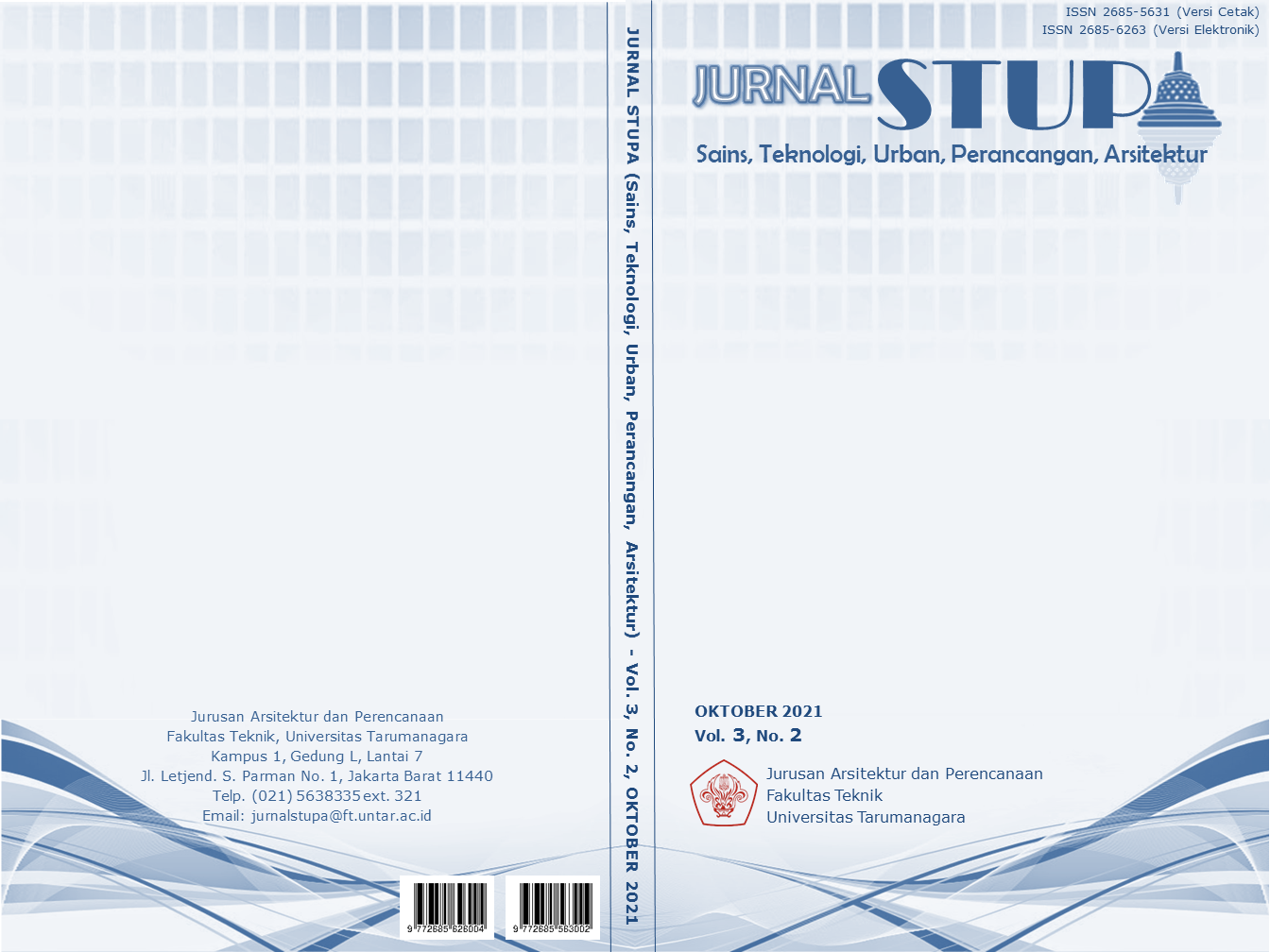FASILITAS PENANGANAN HEWAN TERLANTAR
Main Article Content
Abstract
The development of technology and society's economy is one of the driving factors for growth in an urban environment. This development does not only occur in physical terms, but there is also a shift in the social and cultural elements of society. The nature of urban society tends to be individualistic, capitalist, more concerned with speed or something that is considered instant and is no longer familiar with nature, plants, and animals. Things that are considered unprofitable tend to be removed. Humans, animals and plants should coexist even if an area has turned into a big city. The existence of abandoned animals is an inseparable component of life in urban areas. The population of animals such as stray dogs and stray cats that continue to soar will certainly affect the ecosystem in urban areas. In the end, the disruption of the ecosystem will also affect human life, such as increasing the spread of diseases from animals to humans to increasing road accidents. For this reason, human efforts are needed to deal with the problems of street animals which are actually an inseparable part of the city, as well as efforts to bring the interaction between city humans and animals closer. Rengkuh is also present as a project that seeks to become a container for handling abandoned animals on the streets of BSD City.
Keywords: Ecology; Pet; Stray Animal; Urban; Rengkuh Asuh
Abstrak
Perkembangan teknologi dan ekonomi masyarakat menjadi salah satu faktor pendorong terjadinya pertumbuhan di suatu lingkungan urban. Perkembangan itu tidak hanya terjadi dalam segi fisik, melainkan juga terdapat pergeseran pada unsur sosial dan budaya dari masyarakat. Sifat masyarakat urban cenderung individualistis, kapitalis, lebih mementingkan kecepatan atau sesuatu yang dianggap instan, serta tidak lagi akrab dengan alam, tumbuhan dan hewan. Hal yang dianggap tidak menguntungkan cenderung disingkirkan. Manusia, hewan dan tumbuhan seharusnya hidup berdampingan meskipun suatu wilayah telah berubah menjadi sebuah kota besar. Keberadaan hewan terlantar merupakan komponen yang tidak dapat terpisahkan di dalam kehidupan di perkotaan. Populasi dari hewan seperti anjing dan kucing jalanan yang terus melonjak tentu akan mempengaruhi ekosistem di dalam perkotaan. Pada akhirnya terganggunya ekosistem itu juga akan turut mempengaruhi kehidupan manusia, seperti meningkatnya penyebaran penyakit dari hewan ke manusia hingga peningkatan kecelakaan di jalanan. Untuk itu diperlukan upaya manusia untuk menangani permasalahan dari hewan jalanan yang sebenarnya juga merupakan bagian yang tidak terpisahkan dari kota, juga upaya mendekatkan kembali interaksi antara manusia kota dengan hewan. Rengkuh Asuh pun hadir menjadi sebuah proyek yang berupaya menjadi wadah penanganan hewan terlantar di jalanan Kota BSD.
Article Details
Section
References
Azhar, M. M., Butarbular, R. M., Ekowati, R. V., Ermawanto, Emawati, Hukmi, A., Kurniawan, W. E., Nurtanto, S., Pujiatmoko, Rasa, F. S. T., Suseno, P. P., Wicaksono, A., & Yupiana, Y. (2019). National Master Plan for Eradicating Rabies in Indonesia. Direktorat Jendral Peternakan Dan Kesehatan Hewan Kementerian Pertanian, 1–100. http://keswan.ditjenpkh.pertanian.go.id/?p=2681
Burgos-Cáceres, S. (2011). Canine rabies: A looming threat to public. Animals, 1(4), 326–342.
Coppinger, R. (2001). Dogs: A Startling New Understanding of Canine Origin, Behavior & Evolution. New York: Scribner.
Garrity, T.F., Stallones, L., Mark, M.B & Johnson, T.P. (1989). Pet Ownership and Attachment as Supportive Faktor in the Health of the Eldery. Antrozoos, 3(1), 35-44
Grandgeorge, M., & Hausberger, M. (2011). Human-animal relationships : from daily life to animal-assisted therapies. May 2014.
Guilloux, A. G. A., Panachão, L. I., Alves, A. J. S., Zetun, C. B., Cassenote, A. J. F., & Dias, R. A. (2018). Stray dogs in urban fragments: Relation between population’s perception of their presence and socio-demographic factors. Pesquisa Veterinaria Brasileira, 38(1), 89–93.
Kennedy, B. P. A., Cumming, B., & Brown, W. Y. (2020). Global strategies for population management of domestic cats (Felis catus): A systematic review to inform best practice management for remote indigenous communities in Australia. Animals, 10(4).
Knobel DL, Kaare M, Fevre E, Cleaveland S. (2007). Dog Rabies and its Control.In Jackson AC, Wunner WH (Ed).Rabies. 2nd ed. USA: Elsevier Inc. Pp 573-594.
J, McNicholas. (2010). Dogs as catalysts for social interactions: Robustness of the effect. British journal of psychology.
Miternique, H. C., & Gaunet, F. (2020). Coexistence of diversified dog socialities and territorialities in the city of concepción, chile. Animals, 10(2).
Mitsui, K., Sato, S., & Kakuma, Y. (2020). Effects of the Community Cats Program on Population Control, Migration, and Welfare Status of Free-Roaming Cats in Tokyo, Japan. Animals, 1–12.
Pratama, R. (2020). Menerka Jumlah Kucing di Jakarta hingga Tahun 2021. Diakses pada 25 Februari 2021. https://kumparan.com/kumparannews/menerka-jumlah-kucing-di-jakarta-hingga-tahun-2021-1547206689104270805
Riza, A. (2020). Detik-detik 4 Pelaku Pukuli Anjing dengan Kayu hingga Mati di Bali. Diakses 24 Februari 2021. https://news.detik.com/berita/d-5071608/detik-detik-4-pelaku-pukuli-anjing-dengan-kayu-hingga-mati-di-bali
Serpell, J. A. (2013). Domestication and history of the cat. The Domestic Cat: The Biology of Its. Cambridge: Cambridge University Press.
Setiawaty, V., Septiawati, C., & Burni, E. (2019). Karakteristik Kasus Fatal Akibat Gigitan Hewan Penular Rabies di Indonesia 2016 – 2017. Media Penelitian Dan Pengembangan Kesehatan, 29(3), 235–242. April, 83–100.

